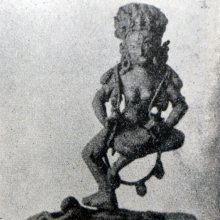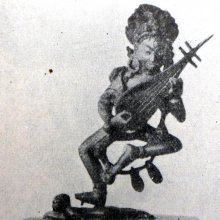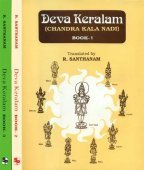Mukunda, Mukundā, Mukumda, Mukunḍā: 21 definitions
Introduction:
Mukunda means something in Buddhism, Pali, Hinduism, Sanskrit, the history of ancient India, biology. If you want to know the exact meaning, history, etymology or English translation of this term then check out the descriptions on this page. Add your comment or reference to a book if you want to contribute to this summary article.
Images (photo gallery)
In Hinduism
Ayurveda (science of life)
Source: Wisdom Library: Āyurveda and botanyMukunda (मुकुन्द) is a Sanskrit word referring to a type of “awned grain” (śūkadhānya), according to Caraka in his Carakasaṃhitā sūtrasthāna (chapter 27), a classical Ayurvedic work. The plant Mukunda is part of the Śūkadhānyavarga group of medicinal plants, referring to the “group of awned grains”. Caraka defined such groups (vargas) based on the dietic value of the plant. Mukunda is similar to Śyāmāka in properties, which it is said to be astringent-sweet and light in character. It also aggravates vāta and alleviates kapha and pitta. It is cold, constipating and absorbent.

Āyurveda (आयुर्वेद, ayurveda) is a branch of Indian science dealing with medicine, herbalism, taxology, anatomy, surgery, alchemy and related topics. Traditional practice of Āyurveda in ancient India dates back to at least the first millenium BC. Literature is commonly written in Sanskrit using various poetic metres.
Purana and Itihasa (epic history)
Source: Cologne Digital Sanskrit Dictionaries: The Purana Index1a) Mukunda (मुकुन्द).—A name of Kṛṣṇa.*
- * Bhāgavata-purāṇa I. 5. 19; Brahmāṇḍa-purāṇa III. 33. 14. IV. 9. 45. 40. 7.
1b) Mountain in Śālmalidvīpa.*
- * Bhāgavata-purāṇa V. 20. 10.

The Purana (पुराण, purāṇas) refers to Sanskrit literature preserving ancient India’s vast cultural history, including historical legends, religious ceremonies, various arts and sciences. The eighteen mahapuranas total over 400,000 shlokas (metrical couplets) and date to at least several centuries BCE.
Vaishnavism (Vaishava dharma)
Source: Pure Bhakti: Brhad BhagavatamrtamMukunda (मुकुन्द) refers to:—A name for Śrī Kṛṣṇa; the giver of liberation. (cf. Glossary page from Śrī Bṛhad-bhāgavatāmṛta).

Vaishnava (वैष्णव, vaiṣṇava) or vaishnavism (vaiṣṇavism) represents a tradition of Hinduism worshipping Vishnu as the supreme Lord. Similar to the Shaktism and Shaivism traditions, Vaishnavism also developed as an individual movement, famous for its exposition of the dashavatara (‘ten avatars of Vishnu’).
In Buddhism
Tibetan Buddhism (Vajrayana or tantric Buddhism)
Source: archive.org: The Indian Buddhist IconographyMukundā (मुकुन्दा) refers to the “kettle-drum” and the deification thereof, as commonly depicted in Buddhist Iconography, and mentioned in the 11th-century Niṣpannayogāvalī of Mahāpaṇḍita Abhayākara.—Her Colour is white; her Symbol is the mukunda instrument; she has two arms.
Mukundā is described in the Niṣpannayogāvalī (vajraḍāka-maṇḍala) as follows:—
Source: academia.edu: The Structure and Meanings of the Heruka Maṇḍala“Mukundā is white in colour. She plays on the instrument called the mukunda with her two hands”.
[All these deities are collectively described as nude, violent in appearance, wearing garlands of skulls and severed heads and dancing in pratyālīḍha. They display the different instruments as their special symbols.]
Mukundā (मुकुन्दा) is the name of a Ḍākinī who, together with the Vīra (hero) named Mukunda forms one of the 36 pairs situated in the Ākāśacakra, according to the 10th century Ḍākārṇava chapter 15. Accordingly, the ākāśacakra refers to one of the three divisions of the dharma-puṭa (‘dharma layer’), situated in the Herukamaṇḍala. The 36 pairs of Ḍākinīs [viz., Mukundā] and Vīras are dark blue in color; they each have one face and four arms; they hold a skull bowl, a skull staff, a small drum, and a knife. Alternatively, the Ḍākinīs have their own marks and motions according to the taste instead of a small drum and a skull staff.

Tibetan Buddhism includes schools such as Nyingma, Kadampa, Kagyu and Gelug. Their primary canon of literature is divided in two broad categories: The Kangyur, which consists of Buddha’s words, and the Tengyur, which includes commentaries from various sources. Esotericism and tantra techniques (vajrayāna) are collected indepently.
India history and geography
Source: Shodhganga: a concise history of Sanskrit Chanda literature (history)Mukunda (मुकुन्द) was the grand-father of Rūpa Gosvāmin (C. 1470-1583 C.E.): author of Aṣṭādaśachandas and erudite scholar of Indian Diaspora who has enriched the Sanskrit literature by his various compositions with the nectar of Vaiṣṇava philosophy. Rūpagosvāmin was the son of Kumāra, grandson of Mukunda, great grandson of Padmanābha and great great grandson of Rūpeśvara, who is the son of Jagadguru Niruddha. He had two brothers namely Vallabha and Sanātana. He was also the uncle of Jīvagosvāmin, son of his younger brother Vallabha. He was a resident of Rāmakeli, a village in Bengal.

The history of India traces the identification of countries, villages, towns and other regions of India, as well as mythology, zoology, royal dynasties, rulers, tribes, local festivities and traditions and regional languages. Ancient India enjoyed religious freedom and encourages the path of Dharma, a concept common to Buddhism, Hinduism, and Jainism.
Biology (plants and animals)
Source: Wisdom Library: Local Names of Plants and DrugsMukunda [ಮುಕುಂದ] in the Kannada language is the name of a plant identified with Boswellia serrata Roxb. ex Colebr. from the Burseraceae (Torchwood) family having the following synonyms: Boswellia glabra, Boswellia thurifera, Bursera thurifera. For the possible medicinal usage of mukunda, you can check this page for potential sources and references, although be aware that any some or none of the side-effects may not be mentioned here, wether they be harmful or beneficial to health.
Source: Google Books: CRC World Dictionary (Regional names)1) Mukunda in India is the name of a plant defined with Boswellia serrata in various botanical sources. This page contains potential references in Ayurveda, modern medicine, and other folk traditions or local practices It has the synonym Boswellia glabra Roxb. (among others).
2) Mukunda in Southern Africa is also identified with Senna petersiana It has the synonym Cassia delagoensis Harv. (etc.).
Example references for further research on medicinal uses or toxicity (see latin names for full list):
· Journal of Ethnopharmacology (1984)
· Kew Bulletin (1988)
· Phytomedicine (2003)
· Agents Actions (1988)
· Elenchus Plantarum Horti Botanici (1802)
· Memoirs of the New York Botanical Garden (1982)
If you are looking for specific details regarding Mukunda, for example chemical composition, side effects, health benefits, diet and recipes, pregnancy safety, extract dosage, have a look at these references.

This sections includes definitions from the five kingdoms of living things: Animals, Plants, Fungi, Protists and Monera. It will include both the official binomial nomenclature (scientific names usually in Latin) as well as regional spellings and variants.
Languages of India and abroad
Sanskrit dictionary
Source: DDSA: The practical Sanskrit-English dictionaryMukunda (मुकुन्द).—[mukum dāti dā-ka pṛṣo° mum]
1) Name of Viṣṇu or Kṛṣṇa.
2) Quicksilver.
3) A kind of precious stone.
4) Name of one of the nine treasures of Kubera.
5) A kind of drum.
6) A kind of grain.
7) (In music) A kind of measure.
8) The resin of the गुग्गुल (guggula) or कुरुन्द (kurunda) tree (Boswellia Thurifera); also मुकुन्दुः (mukunduḥ).
Derivable forms: mukundaḥ (मुकुन्दः).
--- OR ---
Mukundā (मुकुन्दा).—f. A kind of drum; वीणामुकुन्दामुरजादिभिश्च (vīṇāmukundāmurajādibhiśca) Bu. Ch.1.45.
Source: Cologne Digital Sanskrit Dictionaries: Edgerton Buddhist Hybrid Sanskrit DictionaryMukuṇḍa (मुकुण्ड).—m. (= makunda, mukunda), a kind of drum: tuṇapaṇavamṛdaṅgāṃ vīṇaveṇūmukuṇḍāṃ (all mss. ṇḍ) Lalitavistara 80.5 (verse); Tibetan seems to render by rṅa, see s.v. mukunda, qualified by same epithet.
--- OR ---
Mukunda (मुकुन्द).—m. (= mak°, mukuṇḍa), a kind of drum: °daḥ Mahāvyutpatti 5020 = Tibetan rṅa (drum) mu kun da, or rṅa zlum (round); probably read this word for the corrupt muk- kanda of Samādhirājasūtra p. 34 line 9.
Source: Cologne Digital Sanskrit Dictionaries: Shabda-Sagara Sanskrit-English DictionaryMukunda (मुकुन्द).—m.
(-ndaḥ) 1. A name of Vishnu. 2. Gum olibanum. 3. A precious gem. 4. Quicksilver. 5. One of the nine treasures of Kuve- Ra. 6. A kind of drum. E. muku liberation, (from passion, &c.) in the second case mukuṃ and dā to give, aff. ka; or muc to liberate, or muku as before, unda to wet, to sprinkle, aff. ac, deriv. irr.
Source: Cologne Digital Sanskrit Dictionaries: Benfey Sanskrit-English DictionaryMukunda (मुकुन्द).—m. 1. A precious gem. 2. Quicksilver. 3. One of Kuvera’s treasures. 4. A name of Viṣṇu, [Bhāgavata-Purāṇa, (ed. Burnouf.)] 4, 9, 36. 5. Gum olibanum.
Source: Cologne Digital Sanskrit Dictionaries: Cappeller Sanskrit-English DictionaryMukunda (मुकुन्द).—[masculine] [Epithet] of Viṣṇu.
Source: Cologne Digital Sanskrit Dictionaries: Aufrecht Catalogus Catalogorum1) Mukunda (मुकुन्द) as mentioned in Aufrecht’s Catalogus Catalogorum:—son of Puruṣottama, father of Śambhu, grandfather of Rāmadeva and Viśvanāthadeva (Kuṇḍamaṇḍapakaumudī).
2) Mukunda (मुकुन्द):—Kāśīmāhātmyasaṃgraha.
3) Mukunda (मुकुन्द):—Kenopaniṣaṭṭippaṇa. Garuḍopaniṣaṭṭippaṇa. Cūlikopaniṣaddīpikā. Brahmasūtravyākhyā.
4) Mukunda (मुकुन्द):—Puraścaraṇakaumudi. Śivapūjā.
5) Mukunda (मुकुन्द):—Praśnamanoramāṭīkā.
6) Mukunda (मुकुन्द):—Mīranāmnikā Śaṅkaramandārasaurabhaṭīkā.
7) Mukunda (मुकुन्द):—Rāgānugā vivṛti.
8) Mukunda (मुकुन्द):—Padyāvalī.
9) Mukunda (मुकुन्द):—son of Mādhavācāryavajra: Puraścaraṇakaumudī.
Source: Cologne Digital Sanskrit Dictionaries: Monier-Williams Sanskrit-English Dictionary1) Mukunda (मुकुन्द):—m. (cf. muku) Name of Viṣṇu (sometimes transferred to Śiva), [Mahābhārata; Bhāgavata-purāṇa]
2) of a celebrated saint, [Religious Thought and Life in India 318]
3) of a [particular] treasure, [Mārkaṇḍeya-purāṇa]
4) a kind of precious stone, [cf. Lexicographers, esp. such as amarasiṃha, halāyudha, hemacandra, etc.]
5) a kind of grain, [Caraka]
6) the resin of Boswellia Thurifera, [Bhāvaprakāśa]
7) a kind of drum or kettle-drum, [cf. Lexicographers, esp. such as amarasiṃha, halāyudha, hemacandra, etc.]
8) (in music) a kind of measure, [Saṃgīta-sārasaṃgraha]
9) Name of various scholars and authors (also with miśra, paṇḍita, dīkṣita, śarman, kavi, parivrājaka; cf. [compound]), [Catalogue(s)]
10) of a mountain, [Viṣṇu-purāṇa]
Source: Cologne Digital Sanskrit Dictionaries: Yates Sanskrit-English DictionaryMukunda (मुकुन्द):—(ndaḥ) 1. m. Vishnu; gum olibanum; a gem; quicksilver; one of Kuvera's treasures.
Source: DDSA: Paia-sadda-mahannavo; a comprehensive Prakrit Hindi dictionary (S)Mukunda (मुकुन्द) in the Sanskrit language is related to the Prakrit words: Mauṃda, Muuṃda.
[Sanskrit to German]
Sanskrit, also spelled संस्कृतम् (saṃskṛtam), is an ancient language of India commonly seen as the grandmother of the Indo-European language family (even English!). Closely allied with Prakrit and Pali, Sanskrit is more exhaustive in both grammar and terms and has the most extensive collection of literature in the world, greatly surpassing its sister-languages Greek and Latin.
Kannada-English dictionary
Source: Alar: Kannada-English corpusMukuṃda (ಮುಕುಂದ):—
1) [noun] Viṣṇu.
2) [noun] a kind of drum or kettle-drum.
3) [noun] one of the nine treasures of Kubēra, the Regent of Wealth.
4) [noun] a kind of bird.
5) [noun] the tree Boswellia serrata ( = B. thurifera) of Burseraceae family; Indian olibanum tree.
6) [noun] the fragrant gum resin obtained from this tree.
Kannada is a Dravidian language (as opposed to the Indo-European language family) mainly spoken in the southwestern region of India.
Nepali dictionary
Source: unoes: Nepali-English Dictionary1) Mukunḍā (मुकुन्डा):—n. pl. of मुकुन्डो [mukunḍo]
2) Mukunda (मुकुन्द):—n. 1. Mythol. name of Vishnu or Krishna; 2. quicksilver; 3. a kind of precious stone; 4. a kind of drum; 5. name of one of the nine treasures of Kubera;
Nepali is the primary language of the Nepalese people counting almost 20 million native speakers. The country of Nepal is situated in the Himalaya mountain range to the north of India.
See also (Relevant definitions)
Starts with (+22): Mukunda bhatta, Mukunda bhatta gadagila, Mukunda bhattacarya, Mukunda dikshita dvivedin, Mukunda kavi, Mukunda muni, Mukunda pandita, Mukunda parivrajaka, Mukunda sharman, Mukundabhatta, Mukundabhattiya, Mukundacaturdasha, Mukundachapa, Mukundadasa, Mukundadasagunaleshashtaka, Mukundadeva, Mukundagovinda, Mukundaka, Mukundalala, Mukundam.
Ends with: Kalindimukunda.
Full-text (+142): Maukunda, Mukundu, Mukundaraja, Mukundamala, Kulashekhara, Sujnanavimshati, Makunda, Muku, Mukundam, Mukumda, Mukundabhattiya, Mukundamuni, Mukundadasagunaleshashtaka, Mukundalala, Mukundacaturdasha, Mukundadasa, Mukundamuktavali, Mukundavilasa, Mukundavijaya, Mukundasena.
Relevant text
Search found 59 books and stories containing Mukunda, Mukundā, Mukuṇḍa, Mukumda, Mukuṃda, Mukunḍā; (plurals include: Mukundas, Mukundās, Mukuṇḍas, Mukumdas, Mukuṃdas, Mukunḍās). You can also click to the full overview containing English textual excerpts. Below are direct links for the most relevant articles:
Sahitya-kaumudi by Baladeva Vidyabhushana (by Gaurapada Dāsa)
Text 10.68 < [Chapter 10 - Ornaments of Meaning]
Text 8.13 < [Chapter 8 - Literary Qualities]
Text 11.50 < [Chapter 11 - Additional Ornaments]
The Indian Buddhist Iconography (by Benoytosh Bhattachacharyya)
Garga Samhita (English) (by Danavir Goswami)
Verse 1.17.8 < [Chapter 17 - Description of the Yogurt Theft]
Verse 2.18.27 < [Chapter 18 - The Sight of Śrī Kṛṣṇacandra]
Verse 5.14.12 < [Chapter 14 - The Meeting of King Nanda and Uddhava]
Bhakti-rasamrta-sindhu (by Śrīla Rūpa Gosvāmī)
Verse 2.3.39 < [Part 3 - Involuntary Ecstatic Expressions (sattvika-bhāva)]
Verse 3.3.70 < [Part 3 - Fraternal Devotion (sakhya-rasa)]
Verse 2.1.349 < [Part 1 - Ecstatic Excitants (vibhāva)]
Bhajana-Rahasya (by Srila Bhaktivinoda Thakura Mahasaya)
Text 25 < [Chapter 2 - Dvitīya-yāma-sādhana (Prātaḥ-kālīya-bhajana)]
Text 24 < [Chapter 6 - Ṣaṣṭha-yāma-sādhana (Sāyaṃ-kālīya-bhajana–bhāva)]
Text 13 < [Chapter 1 - Prathama-yāma-sādhana (Niśānta-bhajana–śraddhā)]
Srila Gurudeva (The Supreme Treasure) (by Swami Bhaktivedanta Madhava Maharaja)
Family Duties < [Chapter 1.3 - The Preaching of Śrī Narottamānanda Prabhu to Śrīla Gurudeva]
The Glory of Gauḍīya Guru-paramparā < [Chapter 2.1 - Śrī Guru Tattva and Śrī Guru-sevaka]
Establishing the proper chanting of the Mahā-Mantra < [Chapter 1.6 - Return to Maṭha Life]
Related products


